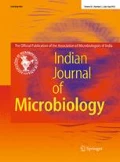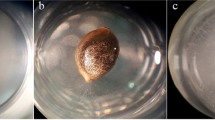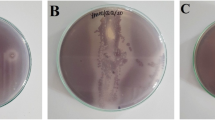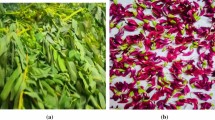Abstract
Screening of fungal isolates collected from different locations of Alexandria coast, Egypt, was carried out to obtain new biologically active metabolites against some virulent fish pathogens (Edwardsiella tarda, Aeromonas hydrophila, Vibrio ordalli and Vibrio angularuim). Among 26 fungal isolates, Aspergillus terreus var. africanus was identified as the most potent isolate. Production of the bioactive material was optimized using response surface methodology including fermentation media, incubation period, temperature, pH, and thermo-stability. Spectral properties of the gas chromatography/mass spectrum of the ethyl acetate crude extract were determined. Partially purified components of the crude extract were chromatographically separated and bioassayed. Out of ten separated compounds, five were with considerable antibacterial agent. The bio-toxicity of crude showed a slight toxicity against the brine shrimp Artemia salina (LC50 = 1,500 μg/l). Antibacterial activity of the crude was compared with some known standard antibiotics and found to be superior over many where its MIC against some pathogen reached 1 μg/ml.




Similar content being viewed by others
References
Arora DS, Chandra P (2010) Assay of antioxidant potential of two Aspergillus isolates by different methods under various physio-chemical conditions. Braz J Microbiol 41(3):765–777
Bugni TS, Abbanat D, Valerie BS, Maiese WM, Greenstein M, Ryan MVW, Ireland CM (2000) Yanuthones: novel metabolites from a marine isolate of Aspergillus niger. J Org Chem 65(21):7195–7200
Bugni TS, Ireland CM (2004) Marine-derived fungi: a chemically and biologically diverse group of microorganisms. Nat Prod Rep 21:143–163
Choi EJ, Park JS, Kim YJ, Jung JH, Lee JK, Kwon HC, Yang HO (2011) Apoptosis-inducing effect of diketopiperazine disulfides produced by Aspergillus sp. KMD 901 isolated from marine sediment on HCT116 colon cancer cell lines. J Appl Microbiol 110(1):304–313
de Vita-Marques AM, Lira SP, Berlinck RGS (2008) A multi-screening approach for marine-derived fungal metabolites and the isolation of Cyclodepsipeptides from Beauveria felina. Quim Nova 31(5):1099–1103
Faulkner DJ (2000) Marine pharmacology. Antonie Van Leeuwenhoek 77:135–145
Gasparetti C, Faccio G, Arvas M, Buchert J, Saloheimo M, Kruus K (2010) Discovery of a new tyrosinase-like enzyme family lacking a C-terminally processed domain: production and characterization of an Aspergillus oryzae catechol oxidase. Appl Microbiol Biotechnol 86(1):213–226
Höller U, Wright AD, Matthee GF, Konig GM, Draeger S, Aust HJ, Schulz B (2000) Fungi from marine sponges: diversity, biological activity and secondary metabolites. Mycol Res 104:1354–1365
Jiang T, Li T, Li J, Fu HZ, Pei YH, Lin WH (2004) Cerebroside analogues from marine-derived fungus Aspergillus flavipes. J Asian Nat Prod Res 6(4):249–257
Kansoh AL, Khattab OH, Abd-Elrazek ZM, Motawea HM (2010) Broad spectrum antimicrobial agent from a local isolate of marine fungus strain. J Appl Sci Res 6(6):580–588
Kiran GS, Hema TA, Gandhimathi R, Selvin J, Thomas TA, Rajeetha RT, Natarajaseenivasan K (2009) Optimization and production of a biosurfactant from the sponge-associated marine fungus Aspergillus ustus MSF3. Colloids Surf B Biointerfaces 73(2):250–256
Kuznetsova TA, Afiyatullov SA, Denisenko VA, Pivkin MV, Elyakov GB (1998) Sterols from a marine isolate of the fungus Cladosporium sphaerospermum Penz. Biochem Syst Ecol 26:365–366
Lee YMH, Li JH, Hee YC, Kyung SB, Mi AK, Dong-Kyoo K, Jee HJ (2010) Bioactive metabolites from the sponge-derived fungus Aspergillus versicolor. Arch Pharm Res 33(2):231–235
Lin A, Lu X, Fang Y, Zhu T, Gu Q, Zhu W (2008) Two new 5-Hydroxy-2-pyrone derivatives isolated from a marine-derived fungus Aspergillus flavus. J Antibiot (Tokyo) 61:245–249
Liu JY, Song YC, Zhang Z, Wang L, Guo ZJ, Zou WX, Tan RX (2004) Aspergillus fumigatus CY 018, an endophytic fungus in Cynodon dactylon as a versatile producer of new and bioactive metabolites. J Biotechnol 3:279–287
Mabrouk AM, Kheiralla ZH, Hamed ER, Youssry AA, Abd El Aty AA (2008) Production of some biologically active secondary metabolites from marine-derived fungus Varicosporina ramulosa. Malays J Microbiol 4(1):14–24
Mendicuti C, Laura P, Trejo-Aguilar BA, Aguilar OG (1997) Thermostable xylanases produced at 37°C and 45°C by a thermotolerant Aspergillus strain. FEMS Microbiol Lett 146:97–102
Meyer BN, Ferringni NR, Putnam JE, Jacobsen LB, Nichols DE, Melaughlin JL (1982) Brine shrimp: aconvenient general bioassay for active plant constituents. J Planta Med 45:31–34
Nguyen HP, Zhang D, Lee U, Kang JS, Choi HD, Son BW (2007) Dehydroxychlorofusarielin B, an antibacterial polyoxygenated decalin derivative from the marine-derived fungus Aspergillus sp. J Nat Prod 70:1188–1190
Ordaz G, D’Armas H, Yáñez D, Hernández J, Camacho A (2010) Secondary metabolites, lethality and antimicrobial activity of extracts from three corals and three marine mollusks from Sucre, Venezuela. Rev Biol Trop 58(2):677–688
Parvatkar RR, Souza CD, Tripathi A, Naik CG (2009) Aspernolides A and B, butenolides from a marine-derived fungus Aspergillus terreus. Phytochem 70:128–132
Punyasloke B, Mohammad BT, Wright PC (2006) The current status of natural products from marine fungi and their potential as anti-infective agents. J Ind Microbiol Biotechnol 33:325–337
Reish DJ, Oshida AS (1987) Manual of methods in aquatic environment reshearch, part (10). Short-term static bioassay. FAO Fish Tech Pap 247:1–62
Rao KV, Sadhukhan AK, Veerender M, Mohan EVS, Dhanvantri SD, Itaramkumar S, Babu MJ, Vyas K, Reddy OG (2000) Butyrolactones from Apergillus terreus. Chem Pharm Bull (Tokyo) 48(4):559–562
Sabu A, Keerthi TR, Kumar SR, Chandrasekaran M (2000) l-Glutaminase production by marine Beauveria sp. under solid state fermentation. Process Biochem 35:705–710
Saleem M, Ali MS, Hussain S, Jabbar A, Ashraf M, Lee YS (2007) Marine natural products of fungal origin. Nat Prod Rep 24:1142–1152
Serrano PH (2005) Responsible uses of Antibiotics in aquaculture food and agriculture organization of the United Nations. Rome, Italy. ISBN 92-5-105436-3
Singh RS, Bhari R, Kaur HP, Vig M (2010) Purification and characterization of a novel thermostable mycelial lectin from Aspergillus terricola. Appl Biochem Biotechnol 162(5):1339–1349
Skouri-Gargouri H, Gargouri A (2008) First isolation of a novel thermostable antifungal peptide secreted by Aspergillus clavatus. Peptides 29(11):1871–1877
Vishwanatha KS, Rao AG, Singh SA (2010) Acid protease production by solid-state fermentation using Aspergillus oryzae MTCC 5341: optimization of process parameters. J Ind Microbiol Biotechnol 37(2):129–138
Wang G (2006) Diversity and biotechnological potential of the sponge-associated microbial consortia. J Ind Microbiol Biotechnol 33:545–551
Wang W, Zhu T, Tao H, Lu Z, Fang Y, Gu Q, Zhu W (2007) Two new cytotoxic quinone type compounds from the halotolerant fungus Aspergillus variecolor. J Antibiot (Tokyo) 60:603–607
Wu ZJ, Ouyanga MA, Tanb QW (2009) New asperxanthone and asperbiphenyl from the marine fungus Aspergillus sp. Pest Manag Sci 65(1):60–65
Xu J, Takasaki A, Kobayashi H, Oda T, Yamada J, Mangindaan RE, Ukai K, Nagai H, Namikoshi M (2006) Four new macrocyclic trichothecenes from two strains of marine-derived fungi of the genus Myrothecium. J Antibiot (Tokyo) 59(8):451–455
Zhang M, Wang WL, Fang YC, Zhu TJ, Gu QQ, Zhu WM (2008) Cytotoxic alkaloids and antibiotic nordammarane triterpenoids from the marine-derived fungus Aspergillus sydowi. J Nat Prod 71(6):985–989
Zhang Y, Ling S, Fang Y, Zhu T, Gu Q, Zhu WM (2008) Isolation, structure elucidation, and antimycobacterial properties of dimeric naphtho-gamma-pyrones from the marine-derived fungus Aspergillus carbonarius. Chem Biodivers 5(1):93–100
Author information
Authors and Affiliations
Corresponding author
Rights and permissions
About this article
Cite this article
Barakat, K.M., Gohar, Y.M. Antimicrobial Agents Produced by Marine Aspergillus terreus var. africanus Against Some Virulent Fish Pathogens. Indian J Microbiol 52, 366–372 (2012). https://doi.org/10.1007/s12088-012-0255-1
Received:
Accepted:
Published:
Issue Date:
DOI: https://doi.org/10.1007/s12088-012-0255-1




